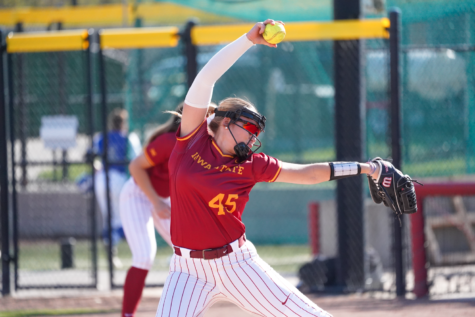Offensive choice
August 26, 2005
It’s a problem every coach and offensive coordinator dreams of having.
A dependable running back to carry an offense on the ground, coupled with a passing attack containing a deep threat and the ability to move the first-down chains.
The ISU football team has employed its running game as a calling card during Dan McCarney’s tenure in Ames.
In eight of his 10 seasons at Iowa State, McCarney has had a 1,000-yard rusher, including running back Troy Davis, who posted back-to-back 2,000-yard years, leading the nation.
After falling short in 2002 and 2003, the Cyclones return a 1,000-yard rusher in junior Stevie Hicks.
The offense also has a potent passing game, with sophomores Bret Meyer and Todd Blythe leading the attack through the air.
“We should be better throwing the ball this year,” McCarney said. “It’s the same guy throwing and the same guys catching. It’s another year in the system, another year of Barney Cotton, so no question we should be better throwing the ball.”
Junior Jon Davis and sophomore Milan Moses also return at wide receiver, and are joined by quarterback-turned-receiver Austin Flynn to add depth to the position.
Although McCarney’s emphasis is the run game, the Cyclones have, in recent years, shown an ability to get things done with the pass.
Former quarterback Seneca Wallace threw for 3,245 yards and 15 touchdowns in 2002 and the Cyclones have had a 2,000 yard passer in five of the last eight seasons.
“You can’t be one dimensional,” quarterbacks coach Todd Fitch said. “You can’t be a total run team and you can’t be a total pass team.
“We’re going to try to maintain balance because you want to be able to do both. We’re going to try to expand on some things and we want to see more efficiency in what we do.”
Finding harmony between the offensive schemes is a focus for the Cyclones as they get ready to begin the season.
“We’re going to do everything we can to be balanced,” McCarney said. “We just want to be more efficient throwing the ball. We’ve got some real good weapons at receiver, no question about it. And we think a real good, talented quarterback, but winning in this league and any place I’ve ever been and coached, you have got to have a rush game. You’ve got to be able to run the ball.
“It’s a little misleading with some of the teams you look at that really throw the ball well, when you look at their run statistics. Sometimes they’re a little skewed, but they still are going to have a back that’s going to be efficient.”
Blythe said he sees the two facets of the game as connected, with one going the way of the other.
“The passing game feeds off the running game and vice versa,” he said. “If Stevie [Hicks] is running the ball well, which he did last season and we expect him to do this season, they’re going to have to load the box up to stop him and we can pick them apart with the passing game.
“The same way, if we’re hitting big plays downfield in the passing game, they’re going to have to move some DBs back and Stevie is the type of runner where if you just put five, six guys in the box he’ll run all day on you. The running game and passing game really help each other.”
Blythe and Meyer connected for six touchdowns as freshmen, transferring a friendship into on-field production.
“I know when I line up at receiver and I see a certain coverage, see them about to blitz, I know he sees the same thing,” Blythe said.
“And he has the confidence to know that I’m picking up blitzes and know how to adjust my routes.
“I know what he’s thinking all the time, and he knows what I’m thinking. It helps that we’re on the same page.”
















